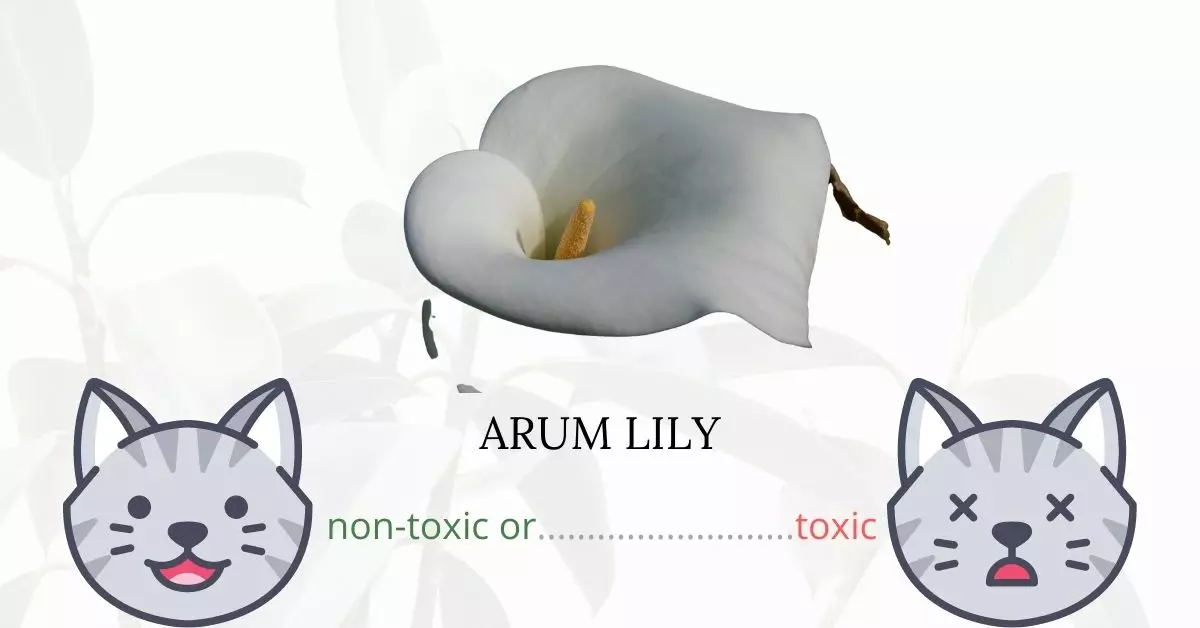Yes, Arum Lilies (also known as Calla Lilies) are toxic to cats. These plants contain insoluble calcium oxalates, which are present in many members of the araceae family. When ingested by cats, these oxalates can penetrate tissues, often leading to mouth irritation, swelling, and even kidney failure. It is imperative that if a cat has consumed any part of an Arum or Calla Lily, immediate veterinary treatment is sought.
This article was crafted in collaboration with a team of experienced DVMs (doctors of veterinary medicine). Their invaluable insights have allowed us to present accurate and up-to-date information regarding the potential risks Arum Lilies pose to feline health. Furthermore, our findings are corroborated by extensive research from high-authority sources such as the ASPCA and PetMD, ensuring the utmost accuracy and reliability of the content provided.
Clinical Signs of Arum Lily or Calla Lily Poisoning in Cats

Arum Lilies or Calla Lilies contain insoluble calcium oxalates, which, when ingested or even just contacted, can lead to a host of symptoms in cats. These calcium oxalates, once inside the body or upon contact with tissues, can initiate a series of reactions. Understanding these reactions can help cat owners recognize the symptoms early and seek veterinary help promptly. Below is a breakdown of the clinical signs and the reasons behind their occurrence:
- Violent shaking of the head and pawing at the mouth: This occurs due to the immediate irritation caused by calcium oxalates. Cats instinctively try to remove or alleviate the uncomfortable sensation.
- Burning sensations in and around the mouth, drooling, and acute inflammation: The tiny, needle-like crystals of calcium oxalate can penetrate the delicate tissues of the mouth, leading to a burning sensation and consequent inflammation.
- Swallowing problems and choking: The irritation and swelling can impede the normal swallowing mechanism, causing distress and possible choking.
- Swelling and pain in the mouth, lips, and throat: Direct contact with the oxalates leads to tissue penetration, resulting in swelling and pain.
- Edema or swelling of the cat’s throat, tongue, and lips: This is a severe inflammatory response to the oxalate crystals.
- Excessive thirst and urination: These are signs of kidney involvement, as the body tries to flush out the toxins.
- Erratic pulse and breathing difficulties: The body’s systemic response to the poisoning can lead to cardiovascular and respiratory distress.
- Vomiting and diarrhea: The ingestion of oxalates irritates the gastrointestinal tract, leading to vomiting and diarrhea.
- Weakness, lethargy, loss of appetite, and depression: These general symptoms indicate the body’s overall distress and potential systemic involvement.
- Dehydration: Caused by excessive vomiting, diarrhea, and increased urination.
- Convulsions and coma: In severe cases, the neurological system gets affected, leading to seizures and possible coma.
- Death: In extreme cases, without immediate and appropriate treatment, death can occur.
If your cat exhibits any of these signs after potential exposure to Arum or Calla Lilies, it’s essential to get them to a veterinary clinic as soon as possible. Early intervention can make a significant difference in the outcome and recovery.
First Aid and Treatment of Arum Lily or Calla Lily Poisoning in Cats

The veterinarian may give medications to ease swelling of your cat’s airways and flush out remaining toxins from your cat’s stomach. Treatments to prevent kidney failure is also essential as permanent your cat is at risk of getting permanent kidney damage. Fluids will be also administered intravenously to prevent dehydration of your cat.
Your cat is at risk of having an anaphylactic reaction as a result of ingesting or being exposed to arum or calla lily thus, your cat will need to be closely monitored by a veterinarian.
Recovery from Arum Lily or Calla Lily Poisoning in Cats

Normally, cats who suffered from arum or calla lily poisoning recover within 18 to 24 hours as long as proper and immediate veterinary care was provided. Give your cat some time to fully recover as he or she regains strength at home.
Prevention of Arum Lily or Calla Lily in Cats
It is recommended for cat owners to avoid growing lilies in their yards. Discarding or giving away gifted arum or calla lilies is also a must to avoid your cat from getting exposed to them indoors.
Most importantly, familiarize yourself with lilies and other toxic plants. Check if arum or calla lilies grow in your neighborhood and take necessary precautions. You can also try to find non-toxic plants that you can grow in your cat-friendly home.
If you love plants but have cats at home, check out these lists:





